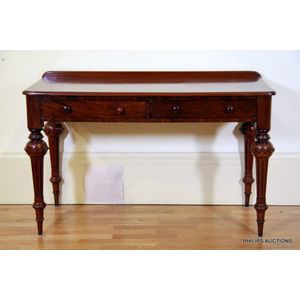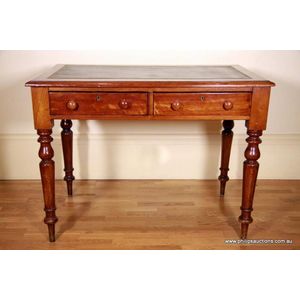Victorian Cedar Leather Desk
You must be a subscriber, and be logged in to view price and dealer details.
Subscribe Now to view actual auction price for this item
When you subscribe, you have the option of setting the currency in which to display prices to $Au, $US, $NZ or Stg.
- Turning - Any part of a piece of furniture that has been turned and shaped with chisels on a lathe. Turned sections include legs, columns, feet, finials, pedestals, stretchers, spindles etc. There have been many varieties and fashions over the centuries: baluster, melon, barley-sugar, bobbin, cotton-reel, rope-twist, and so on. Split turning implies a turned section that has been cut in half lengthwise and applied to a cabinet front as a false decorative support.
- Turned Legs - are legs which have been turned on a lathe. In use from the 16th century, turned legs on tables, chairs and cabinets became more frequent until, by the 1830s, the Georgian square or tapered leg was rarely found except in country pieces.
- Victorian Period - The Victorian period of furniture and decorative arts design covers the reign of Queen Victoria from 1837 to 1901. There was not one dominant style of furniture in the Victorian period. Designers used and modified many historical styles such as Gothic, Tudor, Elizabethan, English Rococo, Neoclassical and others, although use of some styles, such as English Rococo and Gothic tended to dominate the furniture manufacture of the period.
The Victorian period was preceded by the Regency and William IV periods, and followed by the Edwardian period, named for Edward VII (1841 ? 1910) who was King of the United Kingdom and the British Dominions and Emperor of India for the brief period from 1901 until his death in 1910. - Blind Tooling / Blind Tooled - Blind tooling is a technique used in the decoration of leather goods such as book covers, belts, and wallets. It involves the use of specialized tools to impress designs and patterns onto the surface of the leather without the use of added colour.
The process involves the use of a variety of tools, including stamps, embossing tools, and finishing tools, which are used to create various textures and patterns on the leather surface. The tools are heated, and then pressed onto the leather, leaving an impression. The tools can be used to create designs that are simple or complex, with a variety of textures and patterns, including geometric shapes, florals, or scenes. The leather is then burnished to enhance the design and give it a smooth finish. - Tooled - Decoration of a leather surface, usually by stamping the surface with a heated punch or wheel containing foliate or geometric designs. In blind tooling the surface of the punch or wheel is in direct contact with the leather, while in gold tooling, a ribbon of gold leaf is placed between the punch or wheel and the leather, and once they have been applied, the excess gold is brushed off, leaving only the design.
- Gold Tooled - Gold tooling on leather inlays in desks and other furniture and leather book bindings refers to the decorative process of embossing the leather with a design using gold leaf. The design is first traced onto the leather and then incised into the surface using a small blade. The incisions are then gilded with thin sheets of gold leaf. The gold leaf is burnished into the leather to create a raised, metallic design. The process is repeated until the entire design is covered in gold.
- Baluster (furniture) - An architectural term for a column in a balustrade or staircase, often defined as a "vase shape". The shape is extensively used in furniture and decorative arts.
In furniture, it is used to describe a chair or table leg turned in that form, or more usually as an inverted baluster, with the bulbous section to the top. Less commonly used to describe a chair back that has the outline of a baluster. A baluster may also be split and applied to the front of a cupboard for ornamentation.
For ceramics and silver items it is often used to describe the shape of the whole item, rather than a part.
In Georgian glassware, the shape is commonly seen in the stem of glasses.
This item has been included into following indexes:
-
desks, material
- cedar, large 43
- cedar, small 43
- desks, period or age - Victorian 420
Visually similar items

A small Victorian leather topped desk. 19th century, having a tooled green leather top, a bullnose edge and two pine lined frieze drawers with simple timber handles, supported on turned and baluster legs. Height 76 cm. Width 103 cm. Depth 61 cm

A two drawer Victorian mahogany hall table, 19th century, with bull nose edging, a low rear gallery above twin drawers with turned handles, raised on fluted and tapering legs surmounted by impressive studded orbs with centurion skirt embellishments, height

A Victorian mahogany writing table, 19th century, the top with a brown leather tooled writing surface, bullnose edging and apron, raised on turned baluster legs with toupie feet. Height 76 cm. Width 152 cm. Depth 91 cm

A Victorian mahogany two drawer hall table mid 19th century. The table has turned legs with two half size drawers and turned knob handles. Height 73.5 cm. Width 104 cm. Depth 45 cm
